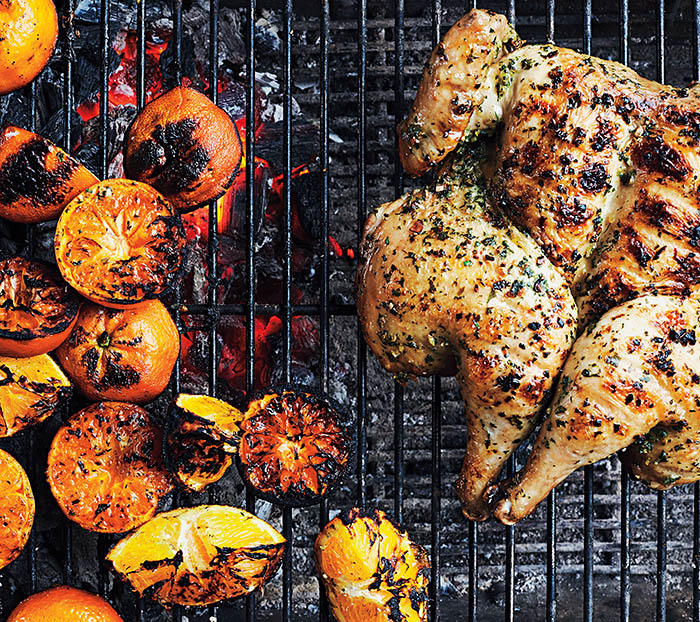
Remove the backbone from a whole bird and it will lie flat, instantly doubling the surface area—and the flavor and crisping potential. This easy technique is called spatchcocking or butterflying. I almost always do chicken like this now, and it’s also perfect for turkey and small birds like pheasants and guinea hens. Figure a 3- to 3-1/2-pound pheasant will take about an hour; a 10- to 14-pound turkey—triple the flavor paste or marinade from any chicken recipe— will take 2 to 2-1/2 hours.
How to Spatchcock a Bird:
STEP 1 With the bird breast down, use kitchen shears or a sharp knife to cut along one side of the backbone.
STEP 2 Cut along the other side of the backbone and remove it.
STEP 3 Flip the bird over, then push down on the breastbone with the heel of your hand to crack it so the bird will lie flat on the grill.
—Mark Bittman
• ON-DEMAND: Listen to Faith talk to Mark about this recipe, as well as others from Mark’s cookbook, How to Grill Everything. •
 Excerpted from HOW TO GRILL EVERYTHING © 2018 by Mark Bittman. Photography © 2018 by Christina Holmes. Reproduced by permission of Houghton Mifflin Harcourt. All rights reserved.
Excerpted from HOW TO GRILL EVERYTHING © 2018 by Mark Bittman. Photography © 2018 by Christina Holmes. Reproduced by permission of Houghton Mifflin Harcourt. All rights reserved.

| Servings |
| 4 people |
| Cook Time |
| 75-95 minutes, largely unattended |
|
|

|
Spatchcocking for Flavorful, Even Cooking: To spatchcock means to butterfly any poultry by cutting out the backbone to open the bird and allow it to lie flat. Since the heat and smoke will get to a spatchcocked bird on all sides, it cooks faster and develops more smokiness. Invest in a pair of sharp, sturdy kitchen shears to make short work of the process. As to the word itself, “spatchcock” is of Irish derivation, and thought to be a mash-up of the words “dispatch” and “cock,” as in, “dispatch the cock.”
|
- 1 (3-4 pound) whole chicken
- 4 cloves garlic (or more), peeled
- 1 teaspoon salt plus more as needed
- 2 tablespoons minced fresh parsley
- 1 tablespoon good-quality olive oil
- pepper
- 1 medium navel orange, halved
- Spatchcock the chicken (see above). With the bird breast up, push down with the heel of your hand to crack the breastbone so the bird will lie flat. Trim excess fat and skin without exposing the meat. Pat the chicken dry with paper towels.
- Mash the garlic with the salt into a paste, then mix with the parsley and oil in a small bowl. Taste and add more salt if necessary and some pepper. Rub the paste all over the chicken. Let the chicken sit at room temperature while you prepare the grill. Or cover and refrigerate for up to 12 hours.
- Start the coals or heat a gas grill for medium-high indirect cooking, preferably for a three-zone fire. Make sure the grates are clean. If using charcoal, put a drip pan under the indirect side of the grill; for gas, empty, clean, and replace the fat trap.
- Put the chicken on the indirect side of the grill, skin side up, so the thighs are as close to the fire as possible without any danger of fat dripping onto the flames or pilot lights. Close the lid and cook until the internal temperature at the thigh, away from the bone, is 165°–170°F, 50 to 70 minutes, depending on the bird’s size. Also check the temperature at the breast; if it’s below 155°F, you can turn the chicken skin side down and move it closer to the fire, or if cooking with gas, turn up the heat on the closest burner.
- When the breast is 155°F, turn the bird and put it directly over the fire until the skin is crisp, 1 to 3 minutes; if using gas, first turn the heat down to medium. At the same time, put the orange halves, cut side down, over the fire. Close the lid and cook until the orange is heated through, just another minute or 2. Transfer the chicken to a cutting board. Let it rest for 5 to 10 minutes, until the internal temperature at the breast comes up to 160°F. Cut into pieces, squeeze the orange over all, and serve.
Variations
Ginger-Cilantro Chicken: Replace the garlic with 2 tablespoons minced fresh ginger and substitute fresh cilantro for the parsley. Substitute two limes for the orange.
Devil’s Chicken: Substitute 1 tablespoon minced rosemary for the parsley and add 2 teaspoons red chile flakes. Substitute a lemon for the orange.
Cambodian-Style Blackened Chicken: Traditionally, the spatchcocked bird would be wrapped and cooked in banana leaves, which are removed to crisp the skin before serving: Omit the garlic, parsley, oil, and salt and pepper. Put the grated zest and juice of 1 lime in a blender or food processor with 3 scallions, chopped, 4 peeled cloves garlic, 2 tablespoons good-quality vegetable oil, and 1 tablespoon each soy sauce, fish sauce, honey, and crushed black peppercorns. Purée, then rub the mixture all over the chicken. Substitute two limes for the orange.

